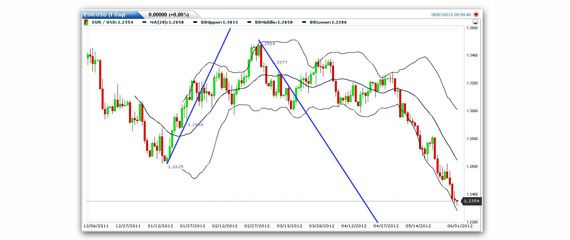Trading Trend or Range
Introduction:
Quite often traders' especially new traders face a dilemma whether to trade trends or trade ranges. This dilemma not only faces forex traders but also stock traders, futures traders and option traders. However, even though trading trends or ranges requires two different mind sets and two different types of money management strategies, the forex market is ideal for traders to trade both trends and ranges.
Trading Trend or Range:
A trend is defined as a series of higher lows (uptrend) or a series of lower highs (downtrend) as indicated by the arrows on the chart below.

Another method of identifying trends is also indicated on the above chart. Bollinger Bands indicate trends when prices contained in the Bollinger Band and either moving from the lower band to the upper band to indicate an uptrend or moving from the upper band to the lower band to indicate a down trend. Another way of defining a trend is by using a 20 period simple moving average where if prices are above the 20 SMA they are in an uptrend and when prices are below the 20 SMA they are in a down trend.
Whichever way a trader defines a trend the end goal is the same, to make a profit. To do this the trend trader needs to identify the trend early and enter the appropriate trade on the right side of the trend. In other words don't buck the trend as the ‘trend is your friend'. If there is an up trend the trader should go long and if there is a down trend the trader should go short. Then stay in the trade until the trend changes direction. If you trend trade then you should not risk more than 2.5% of your capital on any one trade and your stops should be fairly tight and no more than 25 pips behind your entry price.
This clearly means that the market should be liquid and the likelihood of slippage very low and there should be no gap risk as there is in the stock and bond markets. The forex market with its average daily turnover of over $1.5 trillion per day is in fact the most highly liquid financial market in the world. The capacity for large profits for a trend trader is magnified with leverage. A typical leverage is 100:1 therefore you can $100 of your own money and control $10,000. Which means a trend move of 300 pips gives you a nice profit of $300 very quickly. Of course you could also lose the same amount of money and more just as quickly if you decide to buck the market and goagainst the trend or decide not to use any stops.
On the other hand range trading is another strategy altogether. Not the type of range trading where the price oscillates between tight bands. This is still trend trading but on shorter trends. Real range trading is where the trader doesn't care in which direction the price is going because the underling strategy or philosophy is the price will always return to its original point. The trader doesn't actually care in which direction prices are going because the strategy and assumption is such that the trader is in a win/win situation.
If for example the EUR/USD price is at 1.2800 and the trader sells the currency pair and the price rises. The trader would sell the currency every 20 pips the price goes up and then buy it back as it moves down every 15 pips. It will eventually fall back to the 1.2800 price again and the trader would have gained a big profit. If the price falls the trader simply rides the downward trend.
Is it better to trade trends or ranges? That is up to the forex trader and how comfortable he feels about both strategies. Trading both strategies is also a common trading plan.

Register For...
Free Trade Alerts
Education
1-on-1 Support
eToro Copytrader Tips